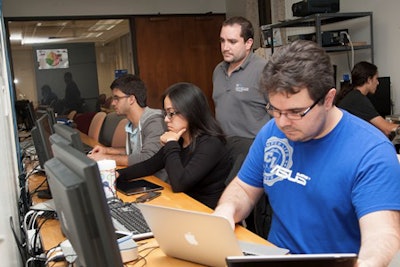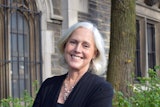 Miami Dade College’s computer research lab serves as a resource where students are encouraged to apply their research skills to solve real-life problems.
Miami Dade College’s computer research lab serves as a resource where students are encouraged to apply their research skills to solve real-life problems.Compelled by his desire to expose Hispanic and Caribbean students to careers in computing and engineering, Dr. Miguel Alonso Jr., chair of Miami Dade College’s School of Engineering and Technology, used a $1 million-plus grant from the National Science Foundation to open a computing research lab in 2010. Today, the lab serves as a resource where students are developed into researchers and encouraged to apply their skills to solve real-life problems.
“Most Hispanic parents want their kids to become doctors or lawyers, so there’s not a lot of push for Hispanic students to go into engineering,” says Alonso. “We reach out to students that aren’t really sure what they want to do, and we expose them to interesting things in engineering. They get to see that there’s a lot of benefit in it and that they can actually do it.”
Hispanic students have earned a larger percentage of college degrees at all levels every year for the past 10 years, but they are still underrepresented in the engineering field. According to the American Society for Engineering Education’s 2012 Profiles of Engineering and Engineering Technology Colleges report, Hispanic students make up 11.4 percent of undergraduate engineering degrees, but are more than 16 percent of the total U.S. population. Further, Hispanic students comprise only 8.9 percent of all graduate engineering degrees and only 6.2 percent of all engineering Ph.D.s.
“What happens is [students] usually stick around for the first four years, and then they’re really not encouraged to continue,” explains Alonso. “The Hispanic culture is very family oriented, and they really don’t want their kids leaving anywhere,” which can be problematic if the STEM education options around them are lacking.
This is where the computing research lab steps in. The lab funds six students each year, many of whom are Hispanic, to spend 10 to 15 hours per week researching and developing projects of their own or advancing projects that other students had begun.
One such project is the Skin Cancer Identification System (SCIDS), an Android-based mobile application that functions as an early warning sign for skin cancer. The idea, first developed by Lisa Richardson, a former electrical engineering student, was one of the first projects developed in the first year of the lab. The project has been picked up by Deborah Bobbio, a senior in electronics engineering technology. The app is geared toward non-specialists so that a primary care physician or a doctor in remote locations could diagnose their patients with more certainty before referring them to a dermatologist.
According to Bobbio, “The user would enter the application, take a picture of the suspected lesion using the smart phone’s camera, and then SCIDS would go through each of the characteristics and give a final percentage of [the] possibility of the lesion being cancerous or not.”
Students are also developing a solar-powered camera network and program, which can analyze video of intersections in real time and automatically count how many cars pass, the rate at which they pass and when and where they will turn. Knowing how many people are on the road at what time allows civil engineers to know if they should expand the road, add more lanes or redirect traffic. It may sound simple enough, and civil engineers do count cars from the hours of videos they take, but it’s currently all done by hand.
“We have a unique curriculum at MDC, where we take [the] abstract nature of some of the topics in engineering and bring them to reality, so it’s very easy for people to make connections between what they’re learning in the classroom and how it applies in real life,” says Alonso.
Students in the lab also engage in Peer-Led Team Learning, where they use their academic strengths to assist their peers. “We coordinate with the teacher to make sure we are teaching [and] reviewing relevant information, but essentially, the material is ‘by students for students,’” says sophomore William Gomez.
With the students’ busy lives, they can spend only so much time in the lab. Development time is slow, but Alonso knows that the lab is about the process of learning, not so much the result. “We can advance the state of the art, but it always has to be about education,” he says. “Everything has to be in pursuit of how to give our students the tools that they need to be successful.”
















